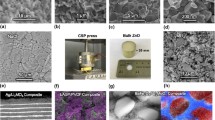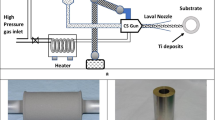Abstract
The influence of the extrusion ratio on sintering behavior of cold-extruded powder mixture Ti-48A1 has been investigated. Both pressureless reaction sintering and hot isostatic pressing (HIP) without encapsulation were carried out. Moreover, two-step sintering,i.e., combination of pressureless sintering and HIP, was conducted. It was found that both porosity and pore size in reactively sintered specimens largely decrease with increaseing extrusion ratio. For a given extrusion ratio, the porosity after pressureless sintering decreases with increasing temperature. Although a reduction of porosity can be reached by directly HIP specimens, the effect of applied pressure in case of combined treatments is strongly dependent on extrusion ratio. By applying an extremely high extrusion ratio of 350, material with a porosity of only 0.7 pct has been prepared by pressureless sintering and subsequent HIP without encapsulation while a reverse treatment route led to a porosity of5%. On the contrary, lower porosities were obtained for low extrusion ratios of 17 and 25 by HIP and following pressureless sintering. The effect of extrusion ratio, as well as sintering temperature, was discussed. In addition, pore coalescing, gas penetration, and swelling were considered in order to understand the effect of applying pressure.
Similar content being viewed by others
References
G.-X. Wang and M. Dahms:Powder Metall. Int., 1992, vol. 24 (4), pp. 219–25.
G.-X. Wang and M. Dahms:Scripta Metall. Mater., 1992, vol. 26 (5), pp. 712–22.
K.B. Mueller, X. Neubert, and M. Dahms: in J.M. Capus and R.M. German, eds.,Advances in Powder Metallurgy & Pariculate Materials—1992, Princeton, NJ, MPIF, 1992, vol. 7, pp. 139–53.
G.-X. Wang, U. Bohnenkamp, and M. Dahms:Proc. Metallographietagung, Dresden, Sept. 30-Oct. 2, 1992, in press.
Y.-W. Kim and D. M. Dimiduk:JOM, 1991, Aug. pp. 40-47.
F.J.J. van Loo and G.D. Rieck:Acta Metall., 1973, vol. 21, pp. 61–71.
G. Leitner, M. Dahms, and S. Schultrich:Proc. 8th Int. Conf. on Powder Metallurgy in CSFR, Pistany, CSFR, Oct. 7-9, A. Salak and M. Selecka, eds., 1992, vol. 2, pp. 243–52.
W. Schart:Pulvermetallurgie Sinter- und Verbundwerkstoffe, VEB Deutscher Verlag für Grundstoffindustrie, Leipzig, 1984.
K. Shibue:Sumitomo Light Met. Tech. Rep., 1991, vol. 32 (2), pp. 95–101.
G.-X. Wang and M. Dahms:Scripta Metall. Mater., 1992, vol. 26 (9), pp. 1469–74.
Author information
Authors and Affiliations
Rights and permissions
About this article
Cite this article
Wang, G.X., Dahms, M. Reaction Sintering of Cold-Extruded Elemental Powder Mixture Ti-48Al. Metall Trans A 24, 1517–1526 (1993). https://doi.org/10.1007/BF02646592
Published:
Issue Date:
DOI: https://doi.org/10.1007/BF02646592




